Premium
From the snowcapped Mt Kenya to the sandy beaches: Kenya, a tourists’ haven
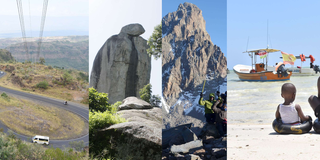
Kenya, a tourists’ haven: From the snowcapped Mt Kenya to the rugged savannah plains, forests and sandy beaches, there are several tourist destinations across the country.
From the snowcapped Mt Kenya to the rugged savannah plains, forests and the Indian Ocean and its sandy beaches, it is very easy to get away and find solitude as a local or visitor in Kenya.
While most Kenyans are famed for visiting the coast each year during holidays, it is astonishing how little is known about other optional destinations spread out across the country.
The Nation team compiled an exciting list of the hidden, and some not-so-hidden, tourist destinations across the country.
This is by no means an exhaustive list, and neither are the facilities rated.
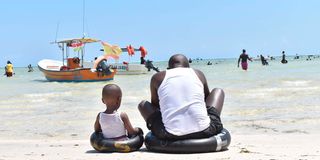
Local tourists enjoy the Sandy Beaches in Mombasa.
Coast circuit
In this part of Kenya, tourists can be assured of rest and relaxation with the most unusual getaways.
The Kenyan coast offers peace and tranquility, punctuated by some unhurried sailing, swimming and eating of the local traditional cuisines.
Expect to enjoy Swahili, Italian, barbeque and fresh seafood.
Activities in Mombasa, Kilifi, Kwale, Lamu and parts of Tana River naturally centre on the ocean. They include Windsurfing, dhow sailing, deep sea fishing, water skiing and snorkeling among others.
Mombasa, Kilifi and Diani (Kwale) and Shella (Lamu) town have earned an enviable reputation as some of the main attractions with white beaches.
Here, sunbathers and beach walkers enjoy a quiet time on the pristine white sandy beaches.
There are also creek cruises, and game park drives in Kwale’s Shimba Hills while Mombasa has Mooring’s, a floating restaurant in Mtwapa Creek, 10km from Mombasa town centre, on your way to the North Coast.
In addition, there are luxury offerings on the coast that offer stunning sea views in addition to Kilifi which has excellent windsurfing, scuba diving and kite-surfing activities.
Association of Hotel Professionals of Kenya deputy secretary Mr Joseph Ndunda says tourism at the coast has experienced mixed fortunes over the years but the general outlook is promising.
"We have seen developments in the sector post-independence for instance tourists who visited Kenya did not need television or phones because they came purely for holiday and relaxation but today's traveller needs WiFi. The industry has moved from analogue to digital because everything is now done through digital platforms," said Mr Ndunda.
The veteran hotelier said the National Parks were not fenced before independence but today the government has heavily invested in the areas to ensure wild animals don't leave their vicinity to destroy properties.
"Today almost all the national parks have been fenced to mitigate human-wildlife conflicts with communities living around the vicinity. We have made strides as a sector, " said Mr Ndunda.
In Mombasa, the Sh1.3 billion modern cruise ship terminal at the port of Mombasa, and the Mombasa-Dubai direct flight to revive the international tourism sector have also revamped the sector, especially international arrivals.
The terminal features a three-story building and has similar facilities just like airports comprising duty-free shops, lounges, restaurants, conference facilities and offices for key stakeholders including port health, logistics and immigration.
The tourism hub has also diversified after the state refurbished the Sh460 million Mama Ngina Waterfront.
"We have made strides in terms of product diversification since independence, improved infrastructure which was a major challenge but lack of open skies policy has denied us tourists," said the Kenya Association of Hotel Keepers and Caterers (KAHC), Coast Executive Officer, Dr Sam Ikwaye.
Dr Ikwaye said the adoption of open skies policy will allow direct flights to land at the Moi International Airport (MIA) Kenya's second largest airport to boost the ailing international tourism sector that dwindled due to Covid-19 pandemic in 2020.
More airlines have expressed interest to land at MIA including Turkish Airlines, Qatar, KLM and Emirates
"Our sector suffered for the first 50 years because we lacked a tourism act to guide it. The sector was developing by itself for the longest time, in the past decade we have seen a tremendous and rough period. Post-independence after 50 years Kenya was doing well. It was on autopilot," said Dr Ikwaye.
Renowned hotelier Mr Mohammed Hersi said Mombasa was for decades served by charter airlines.
"The highest number was in 2007 with 38 charters a week just before the post elections violence, by 2008 we had none. We managed to claw back and recover and by 2012 we had 16 charters," he said.
"Luckily Ethiopian and Rwanda Airlines started to fly and by 2014 Turkish Airlines joined them and by 2017 Qatar was equally allowed which helped us replace the charter business. Jubilee administration in their first term was liberal," he said.
During the pandemic, all flights were suspended globally but upon resumption, Qatar, and Turkish were denied renewal, and even Ethiopian was denied its second flight into Mombasa, he added.
He said the coastal tourism hub which has over 40,000-bed capacity needs direct flight to boost the ailing sector.
In Malindi and Watamu, a predominant foreign market the sector is still struggling with most hotels yet to reopen due to the Covid-19 pandemic.
"Ethiopian Airline was also very keen to date to serve Malindi for the Italian market. KLM also applied to fly directly to Mombasa but their application was also sent to the bins denying Mombasa and Kenya Coast the much-needed seats to help put heads into the beds of these resorts in Kwale. Mombasa, Kilifi, Lamu, Taita Taveta and even Amboseli in Kajiado," he added.
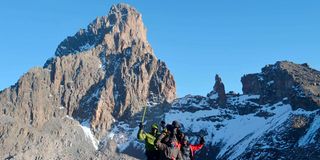
Trekkers pose for a photo at the top of Mt Kenya shortly after summiting the third highest peak, Point Lenana.
Mt Kenya Circuit
The Mt Kenya circuit which covers, Embu, Nyeri, Laikipia, Murang’a Meru Kirinyaga, Nyeri and Nyahururu has different tourism packages ranging from rock and mountain climbing, forest excursions, hiking, boat riding, water rafting, game drives, walks and others.
Central Kenya region stands tall as one of the world’s tourism destinations that is blended by diverse cultural heritage, wildlife conservancies and Africa’s second tallest Mountain – Mt Kenya.
The government has been constructing hiking trails, and sanitation facilities and improving the working condition of porters at Mount Kenya National Park so as to improve visitor’s experience and position the mountain as the preferred hiking destination in Africa.
The region also has Kenya’s big five wildlife.
In Nyeri, there's the Chaka ranch, where families enjoy barbecues and quad bike rides while in the neighbouring Kirinyaga is Sagana rapid falls popular for water sports.
For mountain lovers, the adventure is the most challenging route to use to climb Mt Kenya. Laikipia is famed for its ranches and plains where you can sit by and enjoy a sundowner at the campfires. It also offers picturesque views of Mt Kenya.
Accommodation — guest house and bandas — gets fully booked during the festive period but there is always the option of camping, which is more adventurous anyway.
Embu is known for game drives, guided nature walks, bird watching and community tourism especially not to forget it is the home of the magnificent seven folks dams that generate electricity. The county is also home to wildlife such as zebras, elephants and giraffes.
The Equator passes through Meru onwards to Laikipia and Nyandarua counties the park with beautiful viewpoints and a photography area with curio shops.
There’s also Nanyuki or Mwisho wa Lami, a must-visit for anyone seeking a short but complete break from the demands of corporate and executive life.
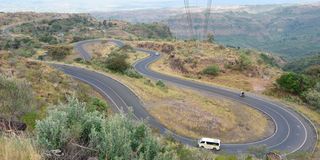
Scenic Rift Valley: Motorists maneuver the numerous meanders on the Kabarnet-Cheploch-Iten road in Baringo County, on the Rift Valley escarpment.
Rift Valley circuit
The region is famed for being one of the areas you can choose to kick off your safari shoes and relax at a spa at one of many luxury resorts and camping sites.
The region offers the perfect laidback getaways in a temperate climate.
Narok’s Maasai Mara which morphs into Serengeti National Park across the border with Tanzania is famous for the wildebeest migration.
Lake Nakuru National Park is a sight to behold. The National Park located to the South of Nakuru City is a beautiful wildlife haven, where tourism merges heart-warming hospitality with spectacular scenery.
The National park has been cited as a tourism haven, and boasted one of the most visited premium parks, generating over Sh1 billion in annual revenue collection.
The park in 2015, was named among the top-rated travel sites, ranking it as the second most colourful lake in the world after Christmas Island in Australia.
This is a three-in-one National park.
The park is located about 140 km (90 miles) northwest of Nairobi.
It can easily be visited in a day tour from the capital or more likely as part of a circuit taking in the Maasai Mara or Lake Baringo, to experience an amazing encounter with wildlife.
The pure volume of flamingos in Lake Nakuru is a highlight.
Making your way to the lookout from Baboon Cliff is a must with views out over the sea of pink flamingos. When they take to the skies, it is amazing scenery.
Almost every visitor traveling to Africa for game viewing hopes to see a rhino.
The good news is, this is one of the most rhino populous places in Kenya, and rhino sightings are expected.
Lake Nakuru's flamingos will steal the show especially when it’s your first time seeing them.
Lake Nakuru hosts the world-famous Lake Nakuru National Park.
Lake Nakuru has been traditionally viewed as a flamingo lake par excellence.
The flamingos made the lake spectacular and natural, making one forget even about beaches altogether.
Apart from flamingos, the lake hosts the world’s renowned Lake Nakuru National Park, which is home to the most majestic wildlife; lions, rhinos, zebras, buffaloes, and several species of birds among others.
Lake Nakuru National Park was designated a bird sanctuary in 1961, extended to 6000 hectares in 1964 and then 63 square kilometers gazetted in 1968.
It was extended to its current size of 188 square kilometers in 1974 through generous funding from the World Wide Fund for Nature (WWF).
In 1984, it was established as the first government-managed rhino sanctuary.
In 1987, it was declared a Ramsar site because of its importance as a wetland, and recently, as a World Heritage Site alongside Lakes Bogoria and Elementaita under the Rift Valley system.
Menengai Crater is another one of Kenya's most intriguing destinations, with spectacular scenery.
The site attracts thousands of visitors from across the country and the globe.
People travel from as far as Uganda, Nigeria, Britain, India Western Kenya and the Coast to congregate in caves for prayers.
The Crater is believed to be a very spiritual place and people come from far and wide to spend time praying and contemplating - and those who have spent time there say they have felt the presence of God. Menengai Crater is located about 5 kilometers North of Nakuru City and a visitor can access Menengai Crater by driving through the posh Milimani Estate, to the north.
It is among the largest surviving volcanic crater in the world, with a surface area of 90 sq km.
Attractions at the caldera include Viewpoints of both Lake Nakuru and the new Nakuru City, hikes and nature trails, Caves, picnic spots, and Menengai crater Menengai caldera.
It is a perfect spot for hiking; you climb the walls of the crater via the long stretch of Murram road strewn with huge gravel to a roadblock manned by several Kenya Forest Service officers.
A visitor has to pay at least Sh200 to be allowed to visit the crater.
After you pay you will be allowed in to enjoy the magical view of this crater.
This means with a budget of just Sh 500, one can visit and enjoy the scenery of Menengai crater.
The Menengai Crater is surrounded by lush forest and is protected by the Kenya Forest Service.
There are numerous flowering plants and grasses, you can see Kirk’s dik dik, slender mongoose. Black-faced vervet monkeys, tree hyrax and mountain reedbuck here.
Also home to Verreaux eagle, Abyssinian ground hornbill and African Marsh Harrier along with other forest species of birds.
There’s also the Subukia Shrine, a religious tourism sites in Nakuru. Located in the Great Rift Valley Escarpment in Subukia, it is one of Kenya’s major religious sites.
Although it is meant to be a shrine for Catholic pilgrims, the Village of Mary Mother of God is also a major tourist attraction.
The shrine is owned by the Kenya Episcopal Conference and managed by a Catholic order, the Franciscan Friars.
It was named the Village of Mary Mother of God in 1984 by Maurice Cardinal Otunga.
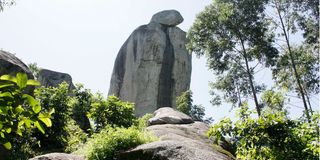
The crying stone of Kakamega.
Western Circuit
Western Kenya region has a rich and enviable mix of tourist attractions that range from historical sites, the captivating beauty of the tropical rain forest and the dazzling beauty of the beaches along Lake Victoria in Busia County.
In Kakamega County, the bullfighting contests have drawn fanatical lovers of the gory sport from different regions of the country and even beyond.
Visitors to Kakamega town, the former headquarters of Western province will be spoilt for choice as they seek to sample the offerings from the rich menu of tourism attractions straddling the region, which include the Kakamega forest and the former Rosterman goldmines.
Other sites are the mythical Crying Stone (locally known as the Ikhonga murwi) which is located a short distance from Ilesi market along the busy Kakamega- Kisumu road.
The bullfighting contests have become a popular sporting activity among the Idakho and Isukha communities from Ikolomani and the neighbouring Shinyalu constituency.
Kakamega forest which is located about 60 kilometres from Kisumu and lies in the Lake Victoria catchment is considered the surviving remains of the Guineo-Congolian rainforest.
The forest and the reserves cover 238 square kilometers. There are 380 species of plants and 367 bird species which include the African blue turaco and the black and white casqued hornbill.
River Yala and river Isiukhu which originate from the Nandi escarpment flow through the forest and empty into Lake Victoria.
The construction of the first phase of an electric fence around the forest, covering 15 kilometres, kicked off in February 2023 at a cost Sh45 million.
The project aims to protect the fragile biodiversity of the rainforest from destruction by illegal loggers and charcoal burners.
The first phase of the project is being funded by the Japanese government in partnership with partners who include the National Environmental Trust Fund (NETFUND), Rhino Ark Charitable Trust, and Kenya Wildlife Service (KWS).
Other partners involved in the project which will cover 117 km when complete are Kenya Forest Service (KFS) and the Vihiga and Kakamega county governments.
The initial funding for the project came from the Japanese government.
Bullfighting along with the abandoned goldmines in Ikolomani has become a major tourism attraction in the region.
In Bungoma County, the Chetambe Fort located on Chetambe hills in Webuye town is one of the unforgettable tourist attractions in western Kenya.
The story of the resistance of the Tachoni community against the colonial administrators, 128 years ago led to the bombing of the Chetambe fort in 1895 after a British colonial administrator, Charles William Hobley gave the orders to his soldiers to use a canon to blast a section of the wall built to secure the fort from hostile communities.
The Tachoni had dug a 12 feet tunnel around the fort, before securing it with the wall. During the attack, the blast from the cannon flattened the wall, killing those living in the compound.
At the site, much of what used to be the fort has been covered in bushes and reduced to ruins but the captivating story of the daring encounter between the British administrator and Tachoni community is still fresh in the minds of residents.
Mr Wasilwa Se-Wekesa, the chairman of the Tachoni community said Chetambe remains a significant history and cultural place due to the hostile encounter between the Tachoni community and the British colonial soldiers.
Other important cultural sites in Bungoma County are the Webuye waterfalls on River Nzoia, and the Nabuyole ridge.
“When one stands at the place where the Chetambe fort had been built, one is able to command a grand view of up to 20 kilometres away and that makes the place very beautiful. We have big plans for the future, which include construction of a cultural centre for the community,” said Mr Se-Wekesa.
Mt Elgon Forest and its legendary caves is an irresistible attraction in Western Kenya region.
Mt Elgon forest ecosystem is one of the five major water towers in the country and the second-highest mountain in Kenya.
The forest is the catchment for River Nzoia which drains into Lake Victoria and River Turkwel which drains into Lake Turkana.
Mt Elgon Park has a variety of scenery which include caves, cliffs, waterfalls, gorges, hot springs, and calderas.
At the Kitum cave, elephants and buffaloes come to lick the natural salt found in the place.
Koitobos is the highest peak on Mt Elgon on the Kenyan side, measuring 4,155 metres (13,632 feet).
In Kakamega County, the Nabongo Cultural Centre, was opened on December 13, 2008, by the current Wanga king, Nabongo Peter Shitawa Mumia 11 and ODM leader Raila Odinga.
The remains of former Wanga kings have been buried at the shrine which lies on a 12 acre parcel of land. The shrine is known as Eshiembekho in the Wanga language.
King Mumia 11 said the government needs to recognize traditional leaders and work with them to promote national cohesion in the country.
“The government should embrace culture by involving us in national events like Toro Kingdom in Uganda where their leaders are treated as royalty. We want our cultural practices preserved for posterity,” said Nabongo.
In Vihiga County, the Mungoma caves have a historical and traditional significance to the Maragoli sub-tribe, the home of the founding ancestors.
The caves have turned into a sight to behold - perhaps because of their association with the origin of Maragoli sub tribe, the second largest in the western region after the Bukusu.
The caves are revered by the community as the place serves as a shrine for the Maragoli sub-tribe.
Surrounded by huge stones on the slopes of the 1,200 acres Maragoli Hills, the caves form the remote village of Mungoma.
The enormous stones are carefully arranged together, leaving hollow openings inside caves that formed the home and shrine used by the ancestors.
A Maragoli elder, Hodari Ragama, 78 says the ancestors settled in the caves and turned it into a home.
From the caves, the populous Maragoli community, their traditions and culture was born.
Mr Ragama explained that the Mulogoli together with his cousins, the Abagusii, journeyed together from Egypt during migration.
The Abagusii, he says, remained in Kisii while the Mulogoli continued further and ended at Mungoma caves.
In Busia County, the beaches along Lake Victoria which include Bumbe, Buyukha, Sio Port and Busijo are an irresistible attraction to visitors of the border county.
- By Winnie Atieno, Eric Matara James Murimi, Benson Amadala, Derick Luvega and Shaban Makokha





